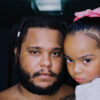“Is he a scientist, a researcher, a philosopher or inventor?” someone can be heard asking in “Becoming Cousteau,” about how best to introduce the great French undersea explorer Jacques Cousteau to American audiences, even with his achievements as monumental as they were not quite making it to the mainstream across the Atlantic. Still, the deep sea diver that had invented the aqualung to spend more time underwater than anyone ever had before and captured his excursions on film so that audiences anywhere could enjoy drew the interest of David Wolper, the legendary producer who would go on to specialize in landmark miniseries such as “Roots” and “The Thorn Birds,” who believed after Cousteau made waves at the Cannes Film Festival, winning a Palme d’Or in 1956 for “The Silent World,” he could be a TV star.
As it is marvelously related in the latest adventure from “What Happened Miss Simone?” director Liz Garbus, Cousteau only found his way to U.S. shores after ABC exec Tom Moore needed a speaker for a meeting of his Explorers Club, taking a flier on 10 episodes if the Frenchman would address the group and inadvertently stumbled into one of the best programming decisions he ever made when “The Undersea World of Jacques Cousteau” would become an instant sensation. With his red beanie and boundless enthusiasm about the ocean, Cousteau became a fixture for generations, which is perhaps why the deconstruction that takes place in “Becoming Cousteau” is so eye-opening, conveying both the good and bad that came with his extraordinary drive. Able to weather both the deaths of an early partner in Maurice Fargues and eventually his second-born son Philippe and find his way to being a prominent conservation advocate after his early exploration brought untold wealth to oil companies that were more than happy to subsequently fund his research and his crew on the Calypso, it’s the complexities of an extraordinary person who wouldn’t let his own emotions get in the way of what he felt was progress at any given time that rise to the surface.
With the wealth of footage that Cousteau had accumulated over his decades of dives, Garbus and editor Pax Wassermann, a frequent collaborator of such experiential documentarians such as “Cartel Land” director Matthew Heineman and “In My Father’s House” Ricki Stern and Annie Sundberg, are able to make it feel as if you’re starboard with the explorer on the Calypso in a physical sense and even closer psychologically as he evolves in his thinking about his place in history and humans’ place in the grander ecosystem. Although Vincent Cassel is enlisted to occasionally read from the great explorer’s journals, much of the film comes from primary sources, a feat that required a depth of discovery that Cousteau would likely even be impressed by as the filmmakers spent the better part of the COVID-19 pandemic excavating old footage from archival houses and restoring much of it to its original luster, inducing the same sense of awe in audiences as it did during the 1960s and ‘70s.
After becoming a hit at Telluride, Toronto and Camden this past month, “Becoming Cousteau” has begun to make its way out to theaters across the country and Wassermann, who admits that the print is practically still wet – fitting, given the subject – was kind enough to talk about how the all-archival biography came together, being as daring as its star in the editing room and conveying a multidimensional life in full without the time to cover every aspect of it.
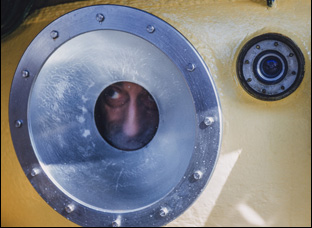
The first question was how much of [Cousteau’s] life we’re going to cover. There had been a co-writer, Mark Monroe, on this, who had done an outline that was the first two-thirds of his life, that ended with [his son] Philippe’s death, and I was definitely drawn to that period, maybe even more so than the later period, because that’s the Cousteau I knew beforehand, but we realized that the first half of his life needed to speak to the second half because it’s a lessons learned film, so [it was a question of] how much do we cover? Who tells the story, in terms of how much we can use his voice, how much other people are using it, and how much can we do with the first person? In the beginning, there were so many recordings with him — there was this great lecture series that he did in France that we use a lot of, and a lot of TV show appearances — in the ‘70s and ‘80s, he was a favorite third guest on talk shows all the time, so that you get good material out of that, but a lot of it was chatty, flirting with somebody sitting next to him on the couch. [laughs] So we started to create a document of guiding lights of things that we found in any form that we knew that had to be in the film, and then those ended up becoming the Vincent Cassel narration. We actually weren’t originally going to do that — we were going to try to do as much as we could with his voice, but there was limits to it. There were things he said that were amazing, but he wrote them in a book or he said them in an interview that was never recorded.
Were you aware of the sheer scope of the archive that’s available going in?
I knew that we were going to get a ton of material from the Cousteau Society, who Liz had worked with for three or four years to set up and get the rights to all that, so I had an idea, but I wasn’t sure how broad it would be, versus a film like “Jane,” where most of that footage is coming from a limited period like three years. We got a lot in ’85 [during the conservation years], and we got a lot in ’62, but then there were kind of dry patches in between. There would be quite a bit of outtakes [from the shows and films he made], which we use, so it’s maybe a different take that wasn’t used if it was a shot in one of his films where [a scene] was a bit more set up — a person running past the deck, and there were a lot of short films that he did early on that we rated to create some of the scenes that feel a little bit more first-person like when he’s first diving. And there were the films themselves and other stuff we just started to find through Tailliez, and that family. We found wonderful little surprises, mostly more in the early parts of his life actually, where we were probably a bit hungrier for material.
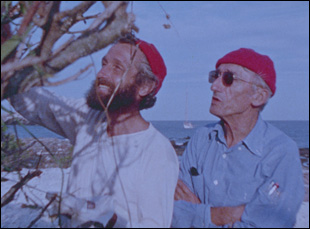
The World War II [sequence] may be what we worked on the most, in terms of his involvement, how much we would go into? There was some missions that he ran as sort of a resistance figure that were quite interesting, but were very context-heavy, so it becomes a bit of a magnet for [how much] historical context you can [have without] getting lost in it because people know there was a war and wonder what’s going on, but even if the things that he’s doing are related very much to when the war was starting or was Vichy in control — he also had a brother who was a Nazi sympathizer, [which] was something we intended to include early on that we ended up excising — it became a little bit too complicated and unwieldy and held us back from getting them on the Calypso. And also, those early short films, “Épaves,” which [translates to] “Shipwrecks,” which went to Cannes and won an award for short film, we included that for awhile, but then just decided to hold back on all the short films, and present the big movie as “A Silent World, because it really was a huge step for him at that point despite the fact that he had made a lot of really wonderful films before.
I believe this is your first all-archival doc. Is it a different process?
It is different. [With] a verite, especially if you keep shooting, you’re always getting new material, but at a certain point this is what you’ve got to work with, and you can lock the doors and figure out what’s at the heart of it. With archival, there’s always a promise of something else that’s coming through that’s going to upend everything you think the movie is — in a positive and a great way actually. The footage with [Maurice] Fargues [for instance], that early death that happened, we didn’t know that existed until pretty late in the process, so that’s definitely changed and then had a lot of pull in that part of the movie.
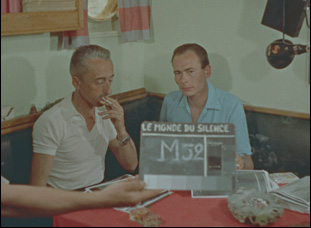
It was a tough call, because we also want this film to play at all ages and that’s a pretty grim thing to be in there, but we felt that since the film was going to end up celebrating him so much, that it needs to be a full-course meal here. People can see through it if it’s not authentic, and that’s not something we’d want to sit on and not include. All the key figures are there — [Philippe] Tailliez is there and it’s too important a moment, so we had to give it, and it was hard to recover from. We need to give people a time after, which is when we talk about some of the split between Tailliez, and in terms of Tailliez being an early conservationist and [how] Cousteau was not quite ready to be that guy yet. He still wanted to go adventure twice.
You connect the emotions to the pace of it. Was that exciting to figure out?
Yeah, there were definitely certain areas that I was really drawn to the filmmaking, and there were so many things happening in “The Silent World” with this great underwater stuff which we show, but it was mostly about, “Let’s just make a film,” and [there was] this enthusiasm that they had to record all of it. Even when we see they have to kill that whale they slam into, that was something that we want to make sure later on the film that we unpack that a little bit and talk about — his relationship to killing animals earlier on [evolves] — but we’re staying with this other feeling [at the time]. And it’s waves of conscience, a lot of highs and lows or moods of reflection when he talks about his flaws, for instance, that coming after a high, which also may be in some ways related to a person who wants to be back in the water. There’s an escape element to being back in the water, [which] is definitely in there in a bunch of lines [where] you want to get away from what’s on land. It’s like filmmaking, particularly when you go on a movie on location where you leave all your troubles behind and you’ve got [only] this as your set of problems, [then] you come back, and it’s switching between these modes. That’s something that we didn’t end up doing as much in the final cut, but whenever he was not on the ship, he was in a suit, getting money, making deals, working on selling the Aqualung, all these other things, so [you’d see him as] these different people all the time. It’s alluded to a little bit, but he had to switch modes a lot in his life.
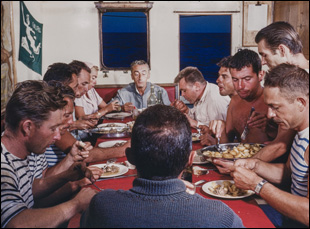
It’s all at once. We had done some pre-interviews with people that we had planned to maybe interview on camera, and then we decided just to go all audio and some of the pre-interview material, we went back to them and just talked about again. I had a lot to work with before they were technically the final interview, so that was easier. It’s actually quite forgiving because you do some of the interviews where like somebody in France on a phone, and it doesn’t sound that great, but it’s also not that dissimilar from an archival interview that would have been done in ‘80 in ’89, so it gave us like a blanket of noise and everything could live in the same space. It helps you live in the moment. Even though there’s one time that we come out for visual interview with Louie Malle, because it’s about their interaction and you have to know who’s talking to, that’s really the only moment that we’re coming out into something that feels like it could be our interview [because of the audio quality], and clearly it’s not. The rest of the stuff’s all archival interviews that we used.
Still, as public as he was, it seems like he kept his cards close to the vest and you learn his wife Simone actually went out of her way to avoid the cameras – was it difficult to figure out how to build them as characters?
He did a lot of interviews, so he’s definitely out there, and especially when he’s promoting shows, and also in his later years with conservation was out there a lot. There was only a couple interviews with her. It was two interviews with the same person that we drew that material from, and it makes you lean in more when you find out somebody didn’t want to be in the public eye. She was definitely one of the big surprises of the film, because I didn’t know how important she was to the ship and to the crew — she was like the heart of the crew and the only woman on the ship, which was very interesting. You could definitely make a great film doc, maybe a fiction film out of her story.
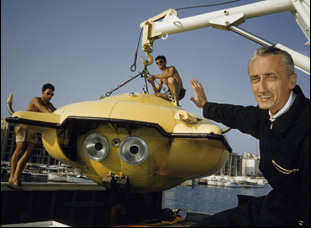
Yeah, it was difficult because the screeners that we got were pretty low resolution and a lot of them were Cintel scans, scanned with all the sprockets on the outside, so we had to push it in in order to fill the frame. You don’t really know what you’re going to get, and that was really scary the last couple of months, [thinking] “Can we have the film we locked?” And “Will we find these masters?” There was a ton of restoration that was done — correction frame-by-frame on a lot of shots and swapping out who has the best master or [asking ourselves] “Should we go back to the beta cam if the film scan isn’t looking as good?” There were also limitations during COVID for [whether] this 35mm clean copy can be located or should we give up and just turn it towards here? We always knew that was going to be an issue and [thought it would be] a couple months process, but it was more like seven months. The film took nine or ten months to cut from when I started to our lock and then we’d have make swaps during that time as well based on what’s going on.
What was it like to see this all come together?
It was in waves as well because when we premiered at Telluride, we didn’t have the best masters yet for a lot of things — some of the restoration wasn’t done, [though] in that screening, the [sound] mix was fantastic. And really up until the cut that was completed like a week-and-a- half ago, there was a ton more of [swapping] masters, clean up and [other] fantastic work that this company Final Frame in New York City did, so I was actually bummed for a little bit earlier on when it wasn’t going to look beautiful and be what it could be, and it’s really tough [when] people [are accustomed to all the] amazing nature photography going on that’s very high resolution. It’s hard to wow people with a shot that’s 16 – and he shot 35 mostly underwater and 16 above actually, but even at 16, if it’s not pristine, it’s how to wow people, and you can constantly say, “Hey, this is the first time anybody shot this,” but it was a concern for us to make sure that the places where it wasn’t in a contextual use, it was just supposed to wow you and that those shots were really amazing.
“Becoming Cousteau” is now out in theaters.

